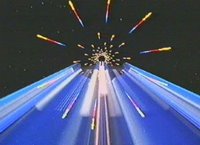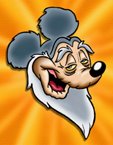EPCOT CENTER 1982!
Part Four...
Rainbows, Chrome and Purple Dragons!
That's why I love Epcot Center 1982!

Today, we’ll focus mainly on style within Epcot’s perimeter…and stylish it definitely was!

As stated yesterday, science fiction and computer advancements had an incredible influence on Epcot’s design in architecture and show concept.

Being a ‘permanent World’s Fair’, the park followed in the path of such predecessors as the 1962 Seattle World’s Fair, The 1964 New York World’s Fair, the 1968 San Antonio HemisFair and the Osaka Expo 1970.

All of these featured state of the art “blue sky’ architecture in their pavilions with an emphasis on mod styling. The Pop Art movement and celebrity industrial designers such as Saul Bass, Raymond Lowey, Verner Panton, Eero Saarinen and the Eames’, all had showcased presentations of exhibition design. There’s little question these elements had a hand in the inspiration of Epcot’s concepts.

Just look at these interior pics of the Communicore section. Rolly Crump was one of the key designers of this kinetic display. There’s a striking resemblance to Charles and Ray Eames’, touring exhibition “Mathematica” and their “Information Machine” presentation for the IBM Pavilion at the 1964 NYWF.

As usual, Disney artists took inspiration from the visual work of others and ‘plussed’ it with the charm that only Disney could.

The thing that draws me to early Epcot more than anything else is how amazingly it captured the sensibility of the time. I call that sensibility “New-Age Sci-Fi”. (Think Jean-Michel Jarre or Stevie Nicks on the Space Shuttle and you're getting warm.)

It was a weird combination of conservatism mixed with science optimism, sprinkled with a dash of soul-less spiritualism.

What I mean by that is the almost religious nature of clean mysticism offered within the park. The pavilions and surrounding grounds were executed with a cold beauty. Everything from the pigmented asphalt to the ethereal drone of synthesizer muzak piped into the air gave one a sense of a new age dream.

1982 Epcot felt a lot like you were walking in the coldly beautiful future of Logan’s Run.

 And, when I say “cold”…it’s a good thing! Star Trek: The Motion Picture was the epitome of this “New-Age Sci Fi”.
And, when I say “cold”…it’s a good thing! Star Trek: The Motion Picture was the epitome of this “New-Age Sci Fi”.
The sci-fi look of the era consisted of chrome and rainbows against starscapes.
Epcot drew much from this combo…


The many pavilions strove to inspire from every angle. Unlike Disneyland, the architecture was presented on a grand, roomy scale.

The distant view was taken full advantage of in that Epcot was a spacious layout.
Nighttime lighting was presented in the spectacle generally regulated to World’s Fairs and Nuremburg Party rallies….

Tomorrow: The High-fallootin' Promise of Epcot!

Part Four...
Rainbows, Chrome and Purple Dragons!
That's why I love Epcot Center 1982!

Today, we’ll focus mainly on style within Epcot’s perimeter…and stylish it definitely was!

As stated yesterday, science fiction and computer advancements had an incredible influence on Epcot’s design in architecture and show concept.

Being a ‘permanent World’s Fair’, the park followed in the path of such predecessors as the 1962 Seattle World’s Fair, The 1964 New York World’s Fair, the 1968 San Antonio HemisFair and the Osaka Expo 1970.

All of these featured state of the art “blue sky’ architecture in their pavilions with an emphasis on mod styling. The Pop Art movement and celebrity industrial designers such as Saul Bass, Raymond Lowey, Verner Panton, Eero Saarinen and the Eames’, all had showcased presentations of exhibition design. There’s little question these elements had a hand in the inspiration of Epcot’s concepts.

Just look at these interior pics of the Communicore section. Rolly Crump was one of the key designers of this kinetic display. There’s a striking resemblance to Charles and Ray Eames’, touring exhibition “Mathematica” and their “Information Machine” presentation for the IBM Pavilion at the 1964 NYWF.

As usual, Disney artists took inspiration from the visual work of others and ‘plussed’ it with the charm that only Disney could.

The thing that draws me to early Epcot more than anything else is how amazingly it captured the sensibility of the time. I call that sensibility “New-Age Sci-Fi”. (Think Jean-Michel Jarre or Stevie Nicks on the Space Shuttle and you're getting warm.)

It was a weird combination of conservatism mixed with science optimism, sprinkled with a dash of soul-less spiritualism.

What I mean by that is the almost religious nature of clean mysticism offered within the park. The pavilions and surrounding grounds were executed with a cold beauty. Everything from the pigmented asphalt to the ethereal drone of synthesizer muzak piped into the air gave one a sense of a new age dream.

1982 Epcot felt a lot like you were walking in the coldly beautiful future of Logan’s Run.

 And, when I say “cold”…it’s a good thing! Star Trek: The Motion Picture was the epitome of this “New-Age Sci Fi”.
And, when I say “cold”…it’s a good thing! Star Trek: The Motion Picture was the epitome of this “New-Age Sci Fi”.The sci-fi look of the era consisted of chrome and rainbows against starscapes.
Epcot drew much from this combo…


The many pavilions strove to inspire from every angle. Unlike Disneyland, the architecture was presented on a grand, roomy scale.

The distant view was taken full advantage of in that Epcot was a spacious layout.
Nighttime lighting was presented in the spectacle generally regulated to World’s Fairs and Nuremburg Party rallies….

Tomorrow: The High-fallootin' Promise of Epcot!



5 Comments:
Man oh man, you sure make the early EPCOT sound cool. The comparison to World's Fairs, "Mathematica", and the "religious nature of clean mysticism" (I do know what you mean...you get that at some museums as well) are all very enticing. It kills me that I never saw it.
By the way, why oh why was Mathematica removed from the California Science Center? It was my absolute favorite thing at the museum!
the science center is about as leaderless as Disneyland these days.
parts of Mathematica can be found at Art Center's School of Design's main galley in Pasadena.
well worth the visit as the school itself is amazing and one of the finest art schools in the country.
Epcot at least in 1990 still had many of the same feelings and had not become the park it is today. It was quite stunning to see the large expanses and all the edutainment rides.
Did Ray and Charles Eames ever work directly with WED?
dom...
i don't believe that happened but....i could be wrong!
Post a Comment
<< Home